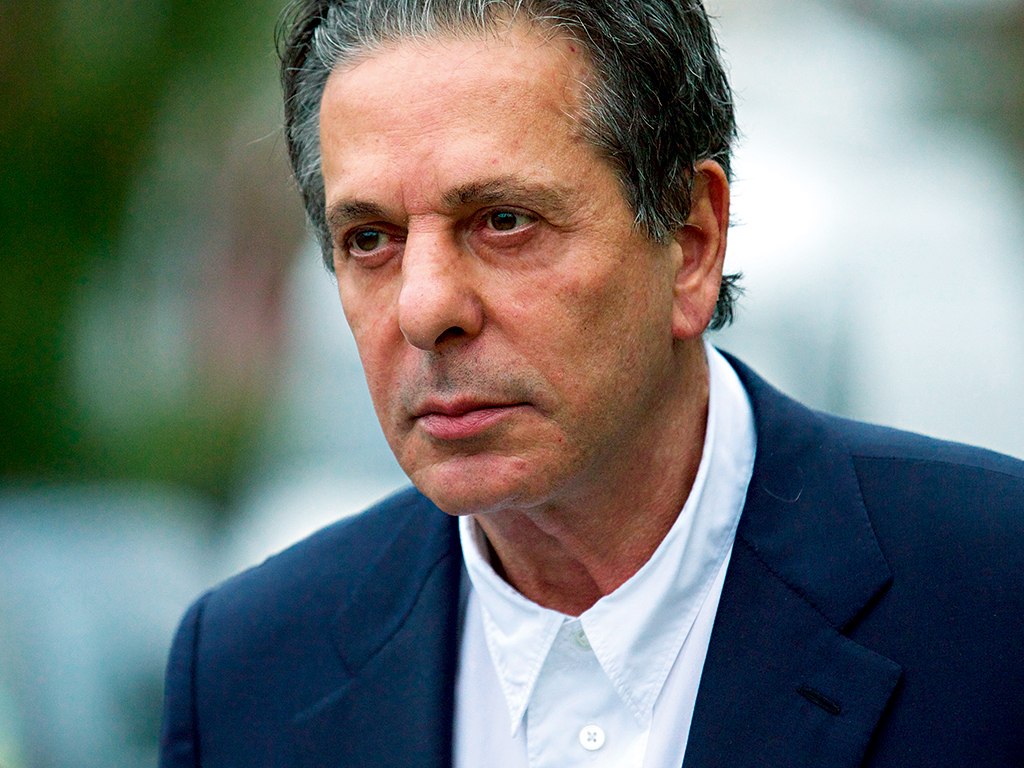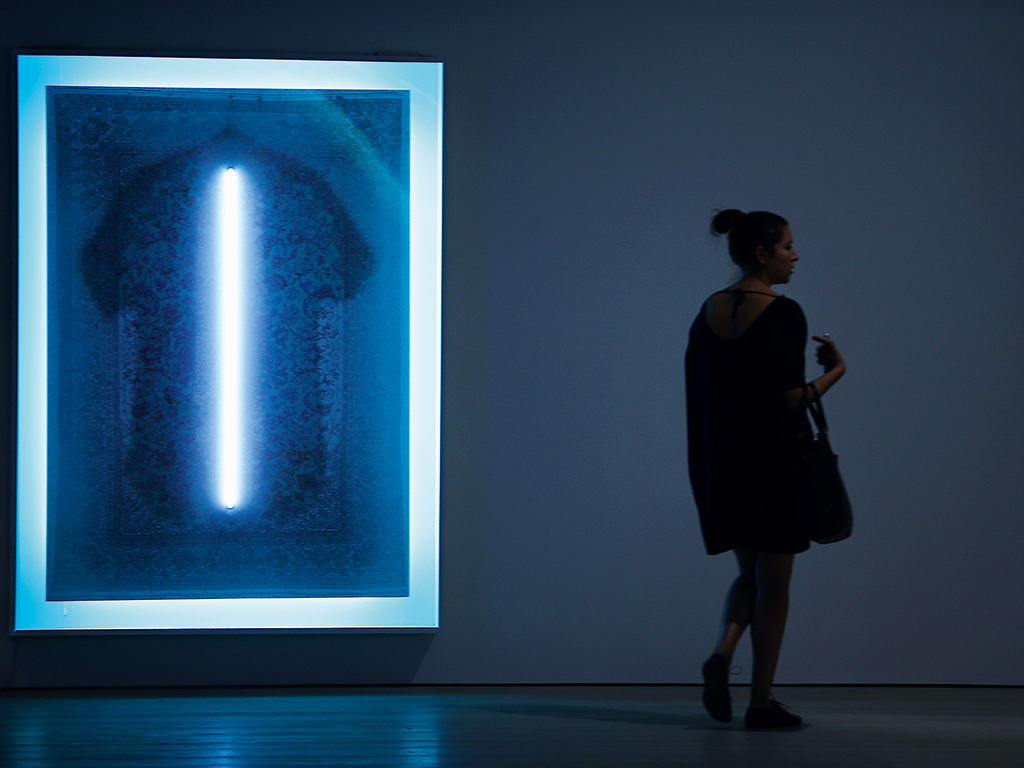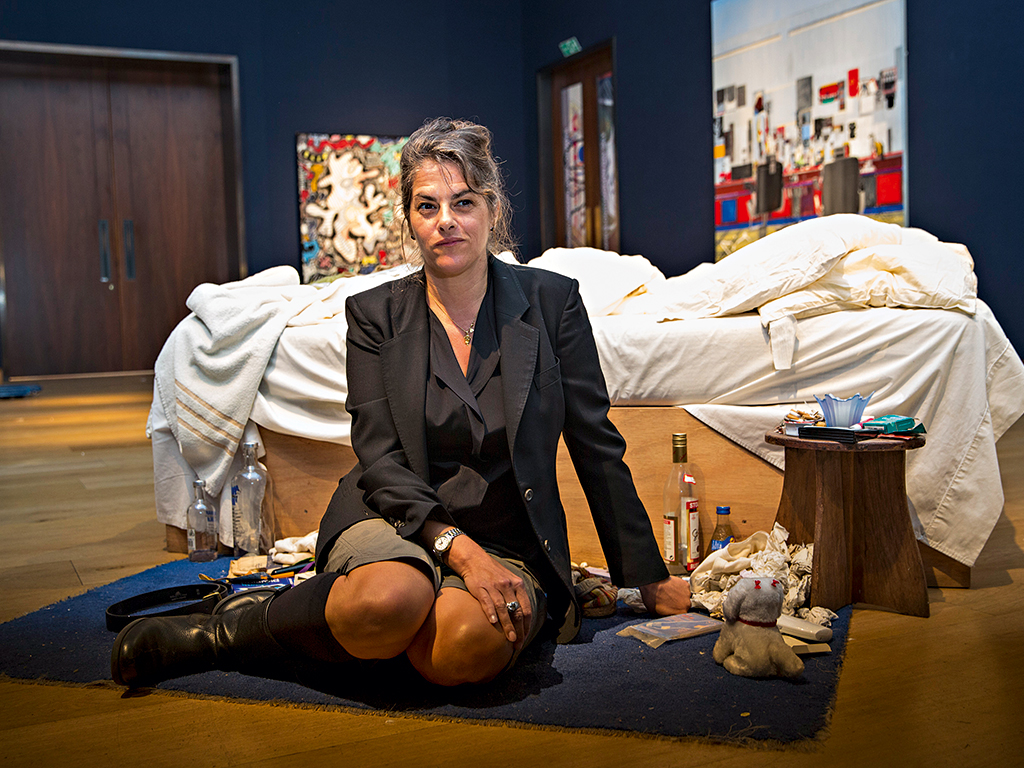
Charles Saatchi is widely credited with having changed the face of the art world in Britain and beyond when he took to the scene in the 1980s and 1990s. The Baghdad-born businessman and obsessive art collector brought contemporary art to London through a controversial, and then-unique, acquisition strategy that saw him change the way the industry operated and transform what people were looking at.
Founding the Saatchi Gallery in 1985 – which now registers over 1.5 million visitors a year – is of course just one side to the story. In addition to his art ventures, the now-multimillionaire created an advertising empire which grew to become the largest in the world in the space of a few years. And through it Saatchi extended his influence yet further, creating original campaigns that went down in history and helped shape the future of the advertising world.
But his ventures, as well as his personal life, have been shrouded in controversy. Artists have at once praised and feared the puppeteer of their market. And an aura of mystery has surrounded his motives; Saatchi seems to be the point where anti-establishment art lover meets cutthroat strategist. Notoriously reclusive and media-shy, he has sought to distance himself from public reach, directing the art and advertising worlds from a quiet, secretive cloister at a time when social media is making most voices louder and louder. That whole strategy – wherein controversy and mystery have somehow blended seamlessly into the life of Saatchi – certainly seems to have worked.
Charles Saatchi: a timeline
Saatchi’s career shows an impressive single-mindedness, focus and desire to succeed
1943
Born on June 9 in Baghdad, Iraq, to parents Nathan and Daisy
1947
Moves to London, eventually settling in Highgate
1965
Joins advertising agency Benton & Bowles
1967
Alongside Art Director Ross Cramer, founds CramerSaatchi
1969
Purchases first piece of art, by US minimalist Sol LeWitt
1970
Founds Saatchi & Saatchi together with brother Maurice
1985
Opens the Saatchi Gallery in a converted paint factory
1986
Saatchi & Saatchi becomes the world’s biggest advertising agency
1992
Hosts the Young British Artists exhibition at the Saatchi Gallery
2010
Donates Saatchi Gallery to the public, casting doubt over his ruthless image
Empire building
It makes perfect sense that a man with such a keen eye for both creativity and commerce should start out in the advertising world. Unlike his seemingly more shrewd and strategic approach to collecting and selling art, however, Saatchi entered the industry by chance, accepting a job as a voucher clerk in a small London advertising agency with just two O Levels under his belt. In 1967, he founded creative consultancy CramerSaatchi, which, with the help of co-founder and brother Maurice, blossomed into Saatchi & Saatchi in 1970.
The brothers took an aggressive acquisition strategy, buying out more than 35 marketing companies between 1972 and 1987 – and it paid off. By 1986, Saatchi & Saatchi had earned a spot on the FTSE 100 and surpassed marketing giants Interpublic and Omnicom to become the biggest communications company in the world. The brothers had put advertising on the map as a viable commercial industry, not just a peripheral sector for the few.
As with many of Saatchi’s achievements, the success of Saatchi & Saatchi was largely dependent on a powerful dose of both originality and controversy. And when the firm won the account for the Conservative Party’s 1979 election campaign and produced the famous ‘Labour Isn’t Working’ line, that became truer than ever. The campaign – credited by many with causing the downfall of the Labour administration and putting Margaret Thatcher into power – was boldly confrontational at a time when political billboards were rare and outright attack almost unheard of. “It marked a sea-change in political advertising”, according to Janine Gibson in The Guardian in 1999. “It was the first to adopt the aggressive marketing tactics which characterise modern elections.”
Saatchi had thus set in motion a method of controlling the world around him from a behind-the-scenes position, influencing both the field of politics and the business of advertising by pulling a few tactful strings. That continued when Maurice was fired from Saatchi & Saatchi and the brothers co-founded M&C Saatchi in 1995 – which became the new go-to for political advertising.
British contemporary art
However, it’s in the art sphere where Saatchi has exercised the greatest level of influence. Taking to a derelict former paint factory in London in 1985 to showcase his collection, he founded the Saatchi Gallery “with the aim of bringing contemporary art to as wide an audience as possible”, according to Nigel Hurst, Saatchi Gallery CEO.
And it worked. Like his advertising campaigns, his 1992 Young British Artists (YBA) exhibition – which included work by Gary Hume, Sarah Lucas and future Turner Prize-winner Damien Hirst – went down in history and catapulted the artists exhibited into the stratosphere, to the awe of a public that was at once outraged and intrigued.
Saatchi had put London on the map as a rival to contemporary art hubs such as Berlin, Paris and New York, and changed the face of the country’s cultural scene at a time when modern art in Britain was limited to the exclusive enjoyment of a select few, according to Hurst. “[The gallery] has been responsible for integrating contemporary art into the nation’s culture by mainstreaming its appeal, making it cool and accessible, and legitimising the making, collecting and appreciation of it”, he told European CEO.
Saatchi’s influence also spread further afield, with a number of Asian artists – including Chinese artist Ai Weiwei and Japanese pop artist Takashi Murakami – citing the YBAs as their inspiration. Under the YBA title, Saatchi had created a new movement where provocative conceptualism met pop art. It was a space where Tracey Emin’s My Bed, an installation complete with cigarette ends, used condoms and stained sheets, met Jenny Saville’s deliberately disturbing paintings of mutilated and obese nude women – a counterattack at the conceptions of feminine beauty depicted by traditional male painters.
Seeking controversy
Saatchi and the artists showcased in his gallery were certainly courting controversy; among the most notable was the aforementioned Turner Prize-winning My Bed, which sparked mixed reactions across the world according to Emin. “In America it was like, yeah, we’ve seen feminist art before, we’ve done it already”, she said at a Christie’s event in London, as reported by the BBC. “In the UK, it just exploded with the Turner Prize. There was nothing in the world in art that has ever looked like this. It changed people’s perceptions of what art is.” Changing the public’s perception was exactly what Saatchi had set out to do, and it appeared to be working.
Among the most hotly debated Saatchi exhibitions was I am a Camera, labelled pornographic by some for featuring photographs of nude children and prompting Scotland Yard’s obscene publications unit to issue a warning. The opening of the new Saatchi Gallery at London’s South Bank in 2003, which featured 160 naked people, was similarly divisive.
Saatchi’s decision to showcase controversial art may well have been part of a strategic, ad-man style move to spark publicity. His mysterious, reclusive persona compounded that; he refrained from attending the South Bank opening. As he had done previously in his advertising successes, he created a buzz from a back seat position, attracting a level of attention that was high enough to defy the need for loud self-promotion.
Maintaining control
Damien Hirst believed controlling the market with money was Saatchi’s main aim. “I think he recognises [art] with his wallet. He’s addicted to shopping”, Hirst said in a 2001 interview with The Guardian. “He suddenly tried to control art. And once you do, art puts a leash around your neck and drags you around by the heels.”
Hirst, then, didn’t believe it was possible to command the art market by pulling the purse strings, but some did. Saatchi was rumoured to have ruined the reputation of Italian neo-expressionist Sandro Chia in the 1980s after he purchased the painter’s work only to sell it off soon after. Hirst himself became a victim of the man who made him, when he was reportedly forced to buy back his own collection from Saatchi for substantially more than he’d sold it, after the latter threatened to sell it all. Instances like this portray Saatchi as a strategic, sly businessman, a dealer in it for the money rather than a collector amassing works of art for the sheer love of them. Those two seemingly polarised ideas have floated around Saatchi since he began acquiring works wholesale in the late twentieth century, and he seems to have courted both ideas in confusingly equal measure.
Indeed at student shows where Saatchi went searching for the next big name, he frequently offered less than half of the artists’ suggested prices, according to reports. Artists Jake and Dinos Chapman felt their work Hell was undervalued when Saatchi bought it for £500,000, and accordingly charged him £1m for a later work as punishment. He made millions on the YBA works, auctioning My Bed for £2.5m (after having bought it for £150,000), selling Hirst’s preserved shark for £5.3m (he paid £50,000), shifting Mark Quinn’s Self for £1.5m (up from a reported £13,000) and raking in £6m for a piece by Peter Doig. All this suggests he knew how to play the market – that his interest in art went beyond a mere collector’s fanaticism.

Two sides
As an advertising guru, that ability to play the market should be of little surprise. But in a rare interview with The Guardian in 2009, Saatchi attacked those very characteristics, clearly attempting to distinguish himself from the dealer category he’s so frequently been boxed into. “These dealers like to feel that they control the market”, he said. “But, of course, by definition, once an artist has a vibrant market, it can’t be controlled.”
He went on to imply he’s more art fanatic than shrewd businessman. “What matters and survives is the art”, he said. “I buy art that I like. Then, if I feel like it, I sell it and buy more art.” He added further that if somebody wants to make a serious investment they’d be better off going for “premium bonds.”
Saatchi’s words suggest something different to others’ perceptions, however. “He’s a cut-throat businessman”, said Hirst to The Guardian in 2001, going on to evoke the fundamental contradiction Saatchi seems to embody. “I bet as a businessman he’s childish. But as an art collector, he’s childlike.”
Before Saatchi, those elements of business-minded dealer and art-obsessed collector were largely polarised and incompatible – the first sold works after a few months for financial gain, the second hoarded them for decades out of sheer pleasure. In Saatchi they collided and fused for the first time. According to art critic Ben Lewis, that ‘specullector’ method is now used by a number of notable art collectors across the world and dominates the art market in China, thanks to Saatchi.
Among the admirers of the technique is art collector-dealer Adam Lindemann. “Mr Saatchi is the original collector who deals”, he wrote in 2011. Lindemann believes claiming that a collector can’t be in it for the money is sheer hypocrisy. Indeed, it seems ironic that Saatchi should be attacked for that, as it’s what contemporary artists have themselves been accused of. Hirst was labelled a conman by some and once confessed he found it “hard to see the art for the dollar signs”. It could even be argued that there is a greater hypocrisy exhibited by artists who subversively react against capitalism, institutions and norms, but are then motivated by capital gain, than there is by someone like Saatchi.
Musings from a mysterious mind
“My aim in life isn’t so much the pursuit of happiness as the happiness of pursuit.”
“My dark little secret is that I don’t actually believe many people in the art world have much feeling for art.”
“Collectors are pretty insignificant in the scheme of things. What matters and survives is the art.”
A studied veil
Whether Saatchi really is a money-seeking monster destroying artists in his wake is still up for debate. It’s contradicted somewhat by his apparent philanthropy. In 2010 he offered to donate his £25m, 200-piece art collection to the British public; an idea withdrawn in 2012 after the Arts Council asked to pick and choose from it. Between 1999 and 2002, the gallery donated over 150 works to the Arts Council and other bodies, and in 2013 Saatchi auctioned off 50 of his biggest installations and sculptures to fund free exhibitions and the gallery’s education programme – with no reserve price.
Some believe that auction was a publicity stunt. Among the sceptics was art critic Louisa Buck. “Nothing Saatchi does is without some kind of strategy or agenda”, she claimed. “It rings with the tenor of the times that they are talking about the proceeds going into access and education.”
And indeed it might well be true that the move was strategic – but it’s impossible to know. The thing with ad-man Saatchi is that the very conflicting nature of these various messages may itself be deliberate, an intentional effort to create a mystery around his motives and a silence that’s become an integral part of his public persona. Deliberate or not, it worked, and he deserves credit for it.
In the words of Charles de Gaulle: “There can be no prestige without mystery, for familiarity breeds contempt.” Mystery is behind Saatchi’s success, marking him out as original and unique against a backdrop of voices competing against each other to steal a slice of the limelight. And these very mixed messages, this very mystery and controversy surrounding everything Saatchi does seems only appropriate for a collector obsessed with contemporary art which, in its very nature, sets out to evade single interpretation, disturb norms and stir up debate by being unique.

A lasting legacy
Following relatively weak reviews of Saatchi’s later exhibitions and substantial changes in the advertising industry since the Saatchi & Saatchi heyday, Saatchi has started to lose his power over recent years – something he freely and openly admits. “I certainly was more dynamic once, building my advertising business and my art collection with ferocious energy”, he told The Guardian. “Now that I have fizzled out, I still enjoy putting on shows of art that I like and introducing new artists to our visitors, so I hope it makes it worthwhile to plod on.”
Saatchi seems well aware that his once-sturdy throne has been threatened by up-and-coming specullectors and curators who bring a more modern edge to a changed art world. And in the advertising realm, new powerhouses like Sir Martin Sorrell, founder and CEO of global communications company WPP, have come to replace the previously
unstoppable magnate.
However, given that Sorrell’s career began at Saatchi & Saatchi, we arguably have Saatchi himself to thank for the new guru – just as we have him to thank for all the myriad specullectors now ironically competing against him. If it wasn’t for Saatchi, the advertising industry might never have grown to become what it did, and Britain might still be rejecting young, contemporary artists in preference of the old masters. Through significant controversy and laudable originality, Saatchi has created a legacy. Whether that controversy was strategic, or whether it stemmed from a genuine love of art, with publicity and financial gain a mere by-product, will never be known. But it’s that very mystery which defines, and will continue to define and drive, Charles Saatchi and his lasting influence.
Courting controversy: Saatchi’s enigmatic image owes much to his regular brushes with scandal
The Saatchi effect
Known for lifting unknown artists to stratospheric levels of success, Saatchi has equally demonstrated his ability to destroy them with ease. The most pertinent example is Italian artist Sandro Chia, whose reputation was irreparably ruined after Saatchi bought and then cheaply sold off his work – something which Saatchi himself denies.
Delicate sensibilities
Championing contemporary art often involves pushing the boundaries. When Saatchi bought Marcus Harvey’s Myra for £11,000, the families of Myra Hindley’s murder victims were incensed. Similarly, there was widespread public outcry and a police warning when Tierney Gearon’s photographs of her nude children were featured in Saatchi’s I am a Camera exhibition.
Domestic disturbance
In 2013, Saatchi was photographed at a restaurant with his hands around the throat of his third wife, TV chef Nigella Lawson. Saatchi maintains that the incident was playful, not serious as was widely reported in the press. The couple divorced the same year, amid claims, denied by Saatchi, of psychological abuse and domestic chaos.

